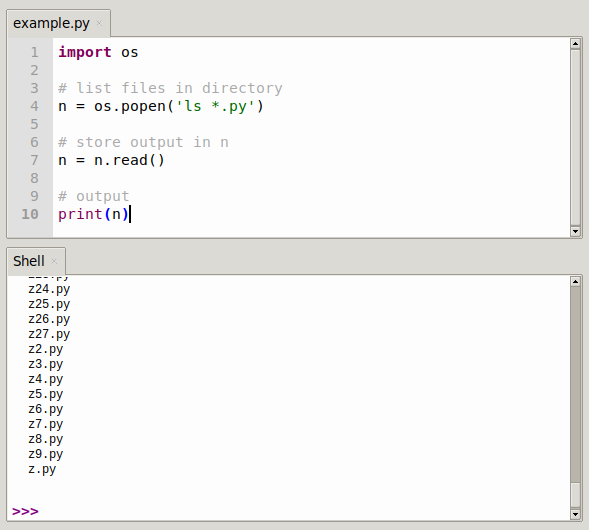Python system command
The os.system() function runs commands on the system, this creates a new process. Using the system function, the child process cannot affect the environment variables in the parent process.
To put it simply, every operation of os.system() opens a child process, which returns the parent process when it is finished, but cannot change the environment variable of the parent process.
Related course: Complete Python Programming Course & Exercises
python run command
The call os module has two functions for command execution: os.system() and os.popen(). These two functions need os this library, before using the import os
The difference between the two functions:
-
os.system() is the state code that is returned after the execution result is executed in the Shell, with 0 indicating a successful execution.
-
os.popen() is the direct return of the execution result, which returns a memory address and parses the data in the memory address with read(). (PS: address or object, C programmers understand address better)
os.system() example
By calling os.system() you can execute a system command, but it does not return the output to Python. This will run a command on your system.
On Linux and Mac the command pwd returns the current directory, but any command will do. You can also use os.system() to start a program.
>>> import os
>>> os.system('pwd')
/home/frank/Pictures
0
>>> os.system('ls')
800px-Fc7-wallpaper.png.jpeg Fedora-16-Wallpaper.png primark-pink-fedora.jpg test.py
9dd027cc6a42f494c219855b04a6f3ee-700.jpg fedora.jpg python-vs-golang.png test.py~
babkinstas-P1430889.JPG gnokii-william-bout-7cdFZmLlWOM-unsplash.jpg ronvau-IMG_4719.JPG vladoxncl-Groyne_Fedora.jpg
darthcookie-juskteez-vu-mwhklqGVzck-unsplash.jpg output.png test.png
0
>>> # output is not stored into variable
>>> n = os.system('ls')
800px-Fc7-wallpaper.png.jpeg Fedora-16-Wallpaper.png primark-pink-fedora.jpg test.py
9dd027cc6a42f494c219855b04a6f3ee-700.jpg fedora.jpg python-vs-golang.png test.py~
babkinstas-P1430889.JPG gnokii-william-bout-7cdFZmLlWOM-unsplash.jpg ronvau-IMG_4719.JPG vladoxncl-Groyne_Fedora.jpg
darthcookie-juskteez-vu-mwhklqGVzck-unsplash.jpg output.png test.png
>>> n
0
os.popen() example
If you call the popen() method it returns the output to Python in the form of a string. The string contains many strings that have the newline character \n.
>>>
>>> # can use os.popen to store output
>>> n = os.popen('ls')
>>> n = n.read()
>>> n
'800px-Fc7-wallpaper.png.jpeg\n9dd027cc6a42f494c219855b04a6f3ee-700.jpg\nbabkinstas-P1430889.JPG\ndarthcookie-juskteez-vu-mwhklqGVzck-unsplash.jpg\nFedora-16-Wallpaper.png\nfedora.jpg\ngnokii-william-bout-7cdFZmLlWOM-unsplash.jpg\noutput.png\nprimark-pink-fedora.jpg\npython-vs-golang.png\nronvau-IMG_4719.JPG\ntest.png\ntest.py\ntest.py~\nvladoxncl-Groyne_Fedora.jpg\n'
>>>

By calling the .split('\n') method you can turn the string into a list.
>>> lines = n.split('\n')
>>> lines
['800px-Fc7-wallpaper.png.jpeg', '9dd027cc6a42f494c219855b04a6f3ee-700.jpg', 'babkinstas-P1430889.JPG', 'darthcookie-juskteez-vu-mwhklqGVzck-unsplash.jpg', 'Fedora-16-Wallpaper.png', 'fedora.jpg', 'gnokii-william-bout-7cdFZmLlWOM-unsplash.jpg', 'output.png', 'primark-pink-fedora.jpg', 'python-vs-golang.png', 'ronvau-IMG_4719.JPG', 'test.png', 'test.py', 'test.py~', 'vladoxncl-Groyne_Fedora.jpg', '']
>>>
So unlike the system() function, the popen function lets you use the output of the commmand in your Python program. For portability issues, make sure the command is available on all desired platforms.